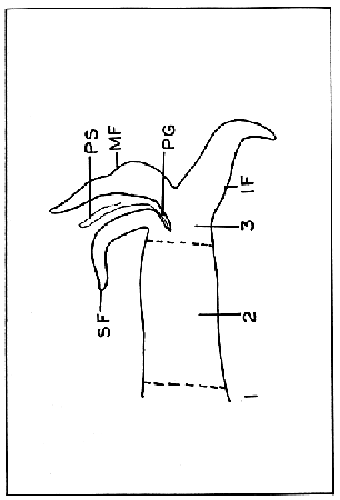The mantle, which is an important part of the molluscan body, is responsible for the secretion of the shell. In the pearl oyster the mantle is bilobed, each consisting of three regions: the marginal, pallial and central mantle (Fig. 5). The free edge of the marginal mantle is thick, pigmented and fringed with branched tentacles. Along the hinge line, the marginal mantles of the two lobes fuse to form the mantle isthmus. The pallial mantle is attached to the shell, a little away from the shell margin, while the central mantle is dorsal to the pallial mantle.
The marginal mantle consists of three folds: the inner, middle and outer fold. Even though the mantle folds look similar morphologically, functionally they are quite different. The inner fold is muscular in activity, the middle sensory, and the outer (shell) fold is secretory in function.
Inner fold
The inner fold is relatively large compared to the other two folds. The fold is lined with ciliated columnar epithelium cells 5–50 μm thick, which have a distinct basal nucleus. The margin of the fold shows a conspicuous pigmentation. Longitudinal and transverse muscle cells, which are also pigmented, are found below the epithelial layer.
Middle fold
The inner margin of the middle fold is similar to the inner margin of the inner fold. The outer margin of the middle fold has ciliated cells, 45 μm in size, columnar in shape, and also with a distinct pigmentation.
Outer (shell) fold
Close to the shell margin is the outer mantle fold. The outer surface of the fold is lined with specialized cells, which are not ciliated or pigmented. Elongated (15–30 μm) stratified columnar epithelial cells occur near the periostracal groove on the inner surface of the fold. Further towards the tip, these cells become smaller in size (10–20 um). However, the arrangement of the columnar epithelial cells, throughout the inner surface from the groove to the tip of the mantle fold, is similar in nature.

FIGURE 5. Section of oyster mantle. (1) Central mantle; (2) Pallial mantle; (3) Marginal mantle. I.F.= inner fold; M.F.= middle fold; S.F.= shell fold; P.G.= periostracal groove; and P.S.= periostracal secretion.
The dorsal marginal mantle or the mantle isthmus consists of non-ciliated columnar epithelial cells. Sub-epithelial or epithelial secretory cells are totally absent in this region.
The portion of the mantle just dorsal to the marginal mantle is known as the pallial mantle. Here, the outer epithelium cells are non-ciliated and smaller (20–30 μm) than those of the ciliated inner epithelium, and are highly vacuolated. Secretory cells are found in both the epithelium, and the sub-epithelium layer.
Below the shell and dorsal to the pallial mantle is the central mantle, which covers the body of the animal. The outer surface of the central mantle is lined with small columnar epithelial cells (10–15 um). Histologically, the secretory cells of the inner epithelium of the central mantle look similar to those of the epithelial cells of the inner pallial mantle.